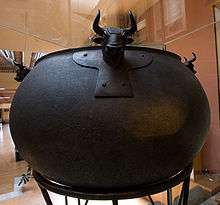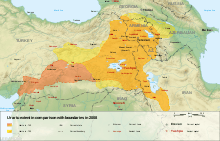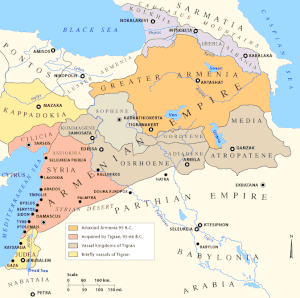Urartu
Urartu (/ʊˈrɑːrtuː/) is a geographical region commonly used as the exonym for the Iron Age kingdom also known by the modern rendition of its endonym, the Kingdom of Van, centered around Lake Van in the historic Armenian Highlands (present-day eastern Anatolia). The kingdom rose to power in the mid-9th century BC, but went into gradual decline and was eventually conquered by the Iranian Medes in the early 6th century BC.[3] The geopolitical region would re-emerge as Armenia shortly after. The Urartians are the most easily identifiable ancestors of the Armenians.[4][5][6][7]
Kingdom of Urartu Biainili[1] | |||||||||||
|---|---|---|---|---|---|---|---|---|---|---|---|
| 860 BC – 590 BC | |||||||||||
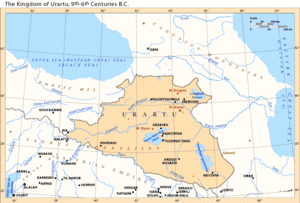 Urartu, 9th–6th centuries BC | |||||||||||
| Capital | |||||||||||
| Common languages | |||||||||||
| Religion | Polytheism | ||||||||||
| Government | Monarchy | ||||||||||
• 858–844 | Aramu | ||||||||||
• 844-834(?) | Lutipri(?) | ||||||||||
• 834–828 | Sarduri I | ||||||||||
• 828–810 | Ishpuini | ||||||||||
• 810–785 | Menua | ||||||||||
• ? | Inushpua(?) | ||||||||||
• 785–753 | Argishti I | ||||||||||
• 753–735 | Sarduri II | ||||||||||
• 735-713 | Rusa I | ||||||||||
• 713-680 | Argishti II | ||||||||||
• 680-639 | Rusa II | ||||||||||
• 639-635 | Sarduri III | ||||||||||
• 635-629(?) | Erimena(?) | ||||||||||
• 629–590 or 629-615 | Rusa III | ||||||||||
• 615–595 | Sarduri IV | ||||||||||
| Historical era | Iron Age | ||||||||||
• Established | 860 BC | ||||||||||
• Median conquest | 590 BC | ||||||||||
| |||||||||||
Names and etymology
Various names were given to the geographic region and the polity that emerged in the region.
- Urartu/Ararat The name Urartu (Armenian: Ուրարտու; Assyrian: māt Urarṭu;[8] Babylonian: Urashtu; Hebrew: אֲרָרָט Ararat) comes from Assyrian sources. Shalmaneser I (1263–1234 BC) recorded a campaign in which he subdued the entire territory of "Uruatri".[9][10] The Shalmaneser text uses the name Urartu to refer to a geographical region, not a kingdom, and names eight "lands" contained within Urartu (which at the time of the campaign were still disunited). Urartu is cognate with the Biblical Ararat, Akkadian Urashtu, and Armenian Ayrarat.[11][12] In addition to referring to the famous Biblical highlands, Ararat also appears as the name of a kingdom in Jeremiah 51:27, mentioned together with Minni and Ashkenaz. Mount Ararat (Turkish: Ağrı Dağı) is located approximately 120 kilometres (75 mi) north of the kingdom's former capital, though the identification of the biblical "mountains of Ararat" with the Mt. Ararat is a modern identification based on postbiblical tradition.[13]
- Van The name Kingdom of Van (Urartian: Biai, Biainili;[14] Վանի թագավորություն),[15] is derived from the Urartian toponym Biainili (or Biaineli), which was probably pronounced as Vanele (or Vanili), and called Van (Վան) in Old Armenian,[16] hence the names "Kingdom of Van" or "Vannic Kingdom".
- Nairi Boris Piotrovsky wrote that the Urartians first appear in history in the 13th century BC as a league of tribes or countries which did not yet constitute a unitary state. In the Assyrian annals the term Uruatri (Urartu) as a name for this league was superseded during a considerable period of years by the term "land of Nairi".[17] However, the exact relationship between Urartu and Nairi is unclear. While the early Urartian rulers referred to themselves as the kings of Nairi, some scholars have suggested that Urartu and Nairi were separate polities. The Assyrians seem to have continued to refer to Nairi as a distinct entity for decades after the establishment of Urartu until Nairi was totally absorbed by Assyria and Urartu in the 8th century BCE[18]
- Khaldini Scholars such as Carl Ferdinand Friedrich Lehmann-Haupt (1910) believed that the people of Urartu called themselves Khaldini after the god Ḫaldi.[19]
- Shupria Shupria (Akkadian: Armani-Subartu from the 3rd millennium BC) is believed to have originally been a Hurrian or Mitanni state that was subsequently annexed into the Urartian confederation. Shupria is often mentioned in conjunction with a district in the area called Arme (also referred to as Urme or Armani) which some scholars have linked to the name of Armenia.[11][12]
- Shurili Linguists John Greppin and Igor M. Diakonoff argued that the Urartians referred to themselves as Shurele (sometimes transliterated as Shurili or Šurili, possibly pronounced as Surili), a name mentioned within the royal titles of the kings of Urartu (e.g. "the king of Šuri-lands”).[20][21] The word Šuri has been variously theorized as originally referring to chariots, swords, the region of Shupria (perhaps an attempt by the ruling dynasty to associate themselves with the Hurrians), or the entire world.[21]
- Armenia In the 6th century BC, with the emergence of Armenia in the region, the name of the region and its people were synonymously[22] referred to as Armenia and Armenians, in two of the three languages used in the Behistun inscription. The name Ararat was translated as Armenia in 1st century AD in historiographical works[23] and very early Latin translations of the Bible,[24] as well as the Books of Kings[25] and Isaiah in the Septuagint. Some English language translations, including the King James Version[26] follow the Septuagint translation of Ararat as Armenia.[27]
History
Origins

Assyrian inscriptions of Shalmaneser I (c. 1274 BCE) first mention Uruartri as one of the states of Nairi, a loose confederation of small kingdoms and tribal states in the Armenian Highlands in the thirteenth to eleventh centuries BCE which he conquered. Uruartri itself was in the region around Lake Van. The Nairi states were repeatedly subjected to further attacks and invasions by the Middle and Neo-Assyrian Empires, which lay to the south in Upper Mesopotamia ("the Jazirah") and northern Syria, especially under Tukulti-Ninurta I (c. 1240 BCE), Tiglath-Pileser I (c. 1100 BCE), Ashur-bel-kala (c. 1070 BCE), Adad-nirari II (c. 900 BCE), Tukulti-Ninurta II (c. 890 BCE), and Ashurnasirpal II (883–859 BC).
Urartu reemerged in Assyrian language inscriptions in the ninth century BCE as a powerful northern rival to the Neo-Assyrian Empire. The Nairi states and tribes became unified kingdom under King Arame of Urartu (c. 860–843 BCE), whose capitals, first at Sugunia and then at Arzashkun, were captured by the Assyrians under the Neo-Assyrian emperor Shalmaneser III.
Urartologist Paul Zimansky speculated that the Urartians, or at least their ruling family after Arame, may have emigrated northwest into the Lake Van region from their religious capital of Musasir.[28] According to Zimansky, the Urartian ruling class were few in number and governed over an ethnically, culturally, and linguistically diverse population. Zimansky went so far as to suggest that the kings of Urartu might have come from various ethnic backgrounds themselves.[29]
Growth

Assyria fell into a period of temporary stagnation for decades during the first half of the 8th century BC, which had aided Urartu's growth. Within a short time it became one of the largest and most powerful states in the Near East[29]
Sarduri I (c. 832–820 BCE), the son of Lutipri, established a new dynasty and successfully resisted Assyrian attacks from the south led by Shalmaneser III, consolidated the military power of the state, and moved the capital to Tushpa (modern Van, Turkey on the shore of Lake Van). His son, Ispuini (c. 820–800 BCE) annexed the neighbouring state of Musasir, which became an important religious center of the Urartian Kingdom, and introduced the cult of Ḫaldi.[29]
Ispuini was also the first Urartian king to write in the Urartian language (previous kings left records written in Akkadian).[29] He made his son Sarduri II viceroy. After conquering Musasir, Ispuini was in turn attacked by Shamshi-Adad V. His co-regent and subsequent successor, Menua (c. 800–785 BCE) also enlarged the kingdom greatly and left inscriptions over a wide area. During Ispuini's and Menua's joint rule, they shifted from referring to their territory as Nairi, instead opting for Bianili.[29]
Urartu reached the highest point of its military might under Menua's son Argishti I (c. 785–760 BCE), becoming one of the most powerful kingdoms of ancient Near East. Argishti I added more territories along the Aras and Lake Sevan, and frustrated Shalmaneser IV's campaigns against him. Argishti also founded several new cities, most notably Erebuni Fortress in 782 BCE. 6600 captured slaves worked on the construction of the new city.

At its height, the Urartu kingdom stretched north beyond the Aras and Lake Sevan, encompassing present-day Armenia and even the southern part of present-day Georgia almost to the shores of the Black Sea; west to the sources of the Euphrates; east to present-day Tabriz, Lake Urmia, and beyond; and south to the sources of the Tigris.
Tiglath-Pileser III of Assyria conquered Urartu in the first year of his reign (745 BCE). There the Assyrians found horsemen and horses, tamed as colts for riding, that were unequalled in the south, where they were harnessed to Assyrian war-chariots.[30]
Decline and recuperation
In 714 BC, the Urartian kingdom suffered heavily from Cimmerian raids and the campaigns of Sargon II. The main temple at Mushashir was sacked, and the Urartian king Rusa I was crushingly defeated by Sargon II at Lake Urmia. He subsequently committed suicide in shame.[31]
Rusa's son Argishti II (714–685 BC) restored Urartu's position against the Cimmerians, however it was no longer a threat to Assyria and peace was made with the new king of Assyria Sennacherib in 705 BC. This in turn helped Urartu enter a long period of development and prosperity, which continued through the reign of Argishti's son Rusa II (685–645 BC).
After Rusa II, however, Urartu grew weaker under constant attacks from Cimmerian and Scythian invaders. As a result, it became dependent on Assyria, as evidenced by Rusa II's son Sarduri III (645–635 BC) referring to the Assyrian king Ashurbanipal as his "father".[32][33]
Fall

According to Urartian epigraphy, Sarduri III was followed by three kings—Erimena (635–620 BC), his son Rusa III (620–609 BC), and the latter's son Rusa IV (609–590 or 585 BC). Late during the 7th century BC (during or after Sarduri III's reign), Urartu was invaded by Scythians and their allies—the Medes. In 612 BC, the Median king Cyaxares the Great together with Nabopolassar of Babylon and the Scythians conquered Assyria after it had been irreversibly weakened by civil war. The Medes then took over the Urartian capital of Van in 590 BC, effectively ending the sovereignty of Urartu.[34][35] Many Urartian ruins of the period show evidence of destruction by fire.
Appearance of Armenia
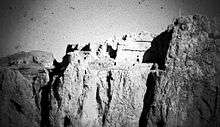
The Kingdom of Van was destroyed in 590 BC[36] and by the late 6th century, the Satrapy of Armenia had replaced it.[37] Little is known of what happened to the region between the fall of the Kingdom of Van and the appearance of the Satrapy of Armenia. According to historian Touraj Daryaee, during the Armenian rebellion against the Persian king Darius I in 521 BC, some of the personal and topographic names attested in connection with Armenia or Armenians were of Urartian origin, suggesting that Urartian elements persisted within Armenia after its fall.[38] In the Behistun Inscription (c. 522 BC) refer to Armenia and Armenians as synonyms of Urartu and Urartians.[22] The toponym Urartu did not disappear, however, as the name of the province of Ayrarat in the center of the Kingdom of Armenia is believed to be its continuum.[39]
As the Armenian identity developed in the region, the memory of Urartu faded and disappeared.[40] Parts of its history passed down as popular stories and were preserved in Armenia, as written by Movses Khorenatsi in the form of garbled legends[41][42] in his 5th century book History of Armenia, where he speaks of a first Armenian Kingdom in Van which fought wars against the Assyrians. Khorenatsi's stories of these wars with Assyria would help in the rediscovery of Urartu.[43]
According to Herodotus, the Alarodians (Alarodioi), presumably a variation of the name Urartian/Araratian, were part of the 18th Satrapy of the Achaemenid Empire and formed a special contingent in the grand army of Xerxes I.[44] According to this theory, the Urartians of the 18th Satrapy were subsequently absorbed into the Armenian nation.[45] Modern historians, however, have cast doubt on the Alarodian connection to the Urartians as the latter are never recorded as having applied an endonym related to "Ararat" to themselves.[46]
In a study published in 2017,[47] the complete mitochondrial genomes of 4 ancient skeletons from Urartu were analyzed alongside other ancient populations found in modern-day Armenia and Artsakh spanning 7,800 years. The study shows that modern-day Armenians are the people who have the least genetic distance from those ancient skeletons.
Geography
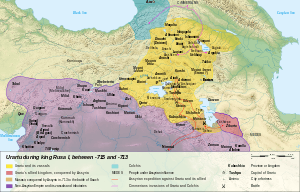
Urartu comprised an area of approximately 200,000 square miles (520,000 km2), extending from the Euphrates in the West to Lake Urmia in the East and from the Caucasus Mountains south towards the Zagros Mountains in northern Iraq.[48] It was centered around Lake Van, which is located in present-day eastern Anatolia.[49]
At its apogee, Urartu stretched from the borders of northern Mesopotamia to the southern Caucasus, including present-day Turkey, Nakhchivan,[50] Armenia and southern Georgia (up to the river Kura). Archaeological sites within its boundaries include Altintepe, Toprakkale, Patnos and Haykaberd. Urartu fortresses included Erebuni Fortress (present-day Yerevan), Van Fortress, Argishtihinili, Anzaf, Haykaberd, and Başkale, as well as Teishebaini (Karmir Blur, Red Mound) and others.
Discovery

Inspired by the writings of the medieval Armenian historian Movses Khorenatsi (who had described Urartian works in Van and attributed them to the legendary Ara the Beautiful and Queen Semiramis), the French scholar Jean Saint-Martin suggested that his government send Friedrich Eduard Schulz, a German professor, to the Van area in 1827 on behalf of the French Oriental Society.[51] Schulz discovered and copied numerous cuneiform inscriptions, partly in Assyrian and partly in a hitherto unknown language. Schulz also discovered the Kelishin stele, bearing an Assyrian-Urartian bilingual inscription, located on the Kelishin pass on the current Iraqi-Iranian border. A summary account of his initial discoveries was published in 1828. Schulz and four of his servants were murdered by Kurds in 1829 near Başkale. His notes were later recovered and published in Paris in 1840. In 1828, the British Assyriologist Henry Creswicke Rawlinson had attempted to copy the inscription on the Kelishin stele, but failed because of the ice on the stele's front side. The German scholar R. Rosch made a similar attempt a few years later, but he and his party were attacked and killed.
In the late 1840s Sir Austen Henry Layard examined and described the Urartian rock-cut tombs of Van Castle, including the Argishti chamber. From the 1870s, local residents began to plunder the Toprakkale ruins, selling its artefacts to European collections. In the 1880s this site underwent a poorly executed excavation organised by Hormuzd Rassam on behalf of the British Museum. Almost nothing was properly documented.
The first systematic collection of Urartian inscriptions, and thus the beginning of Urartology as a specialized field dates to the 1870s, with the campaign of Sir Archibald Henry Sayce. The German engineer Karl Sester, discoverer of Mount Nemrut, collected more inscriptions in 1890/1. Waldemar Belck visited the area in 1891, discovering the Rusa stele. A further expedition planned for 1893 was prevented by Turkish-Armenian hostilities. Belck together with Lehmann-Haupt visited the area again in 1898/9, excavating Toprakkale. On this expedition, Belck reached the Kelishin stele, but he was attacked by Kurds and barely escaped with his life. Belck and Lehmann-Haupt reached the stele again in a second attempt, but were again prevented from copying the inscription by weather conditions. After another assault on Belck provoked the diplomatic intervention of Wilhelm II, Sultan Abdul Hamid II agreed to pay Belck a sum of 80,000 gold marks in reparation. During World War I, the Lake Van region briefly fell under Russian control. In 1916, the Russian scholars Nikolay Yakovlevich Marr and Iosif Abgarovich Orbeli, excavating at the Van fortress, uncovered a four-faced stele carrying the annals of Sarduri II. In 1939 Boris Borisovich Piotrovsky excavated Karmir-Blur, discovering Teišebai, the city of the god of war, Teišeba. Excavations by the American scholars Kirsopp and Silva Lake during 1938-40 were cut short by World War II, and most of their finds and field records were lost when a German submarine torpedoed their ship, the SS Athenia. Their surviving documents were published by Manfred Korfmann in 1977.
A new phase of excavations began after the war. Excavations were at first restricted to Soviet Armenia. The fortress of Karmir Blur, dating from the reign of Rusa II, was excavated by a team headed by Boris Piotrovsky, and for the first time the excavators of a Urartian site published their findings systematically. Beginning in 1956 Charles A. Burney identified and sketch-surveyed many Urartian sites in the Lake Van area and, from 1959, a Turkish expedition under Tahsin Özgüç excavated Altintepe and Arif Erzen.
In the late 1960s, Urartian sites in northwest Iran were excavated. In 1976, an Italian team led by Mirjo Salvini finally reached the Kelishin stele, accompanied by a heavy military escort. The Gulf War then closed these sites to archaeological research. Oktay Belli resumed excavation of Urartian sites on Turkish territory: in 1989 Ayanis, a 7th-century BC fortress built by Rusas II of Urartu, was discovered 35 km north of Van. In spite of excavations, only a third to a half of the 300 known Urartian sites in Turkey, Iran, Iraq, and Armenia have been examined by archaeologists (Wartke 1993). Without protection, many sites have been plundered by local residents searching for treasure and other saleable antiquities.
On 12 November 2017, it was announced that archaeologists in Turkey's eastern Van Province had discovered the ruins of a 3,000-year-old Urartu castle during underwater excavations around Lake Van led by Van Yüzüncü Yıl University and the Governorship of Turkey's eastern Bitlis Province, and that revealed these underwater ruins are from the Iron Age Urartu civilization and are thought to date back to the eighth to seventh centuries BC.[52]
The discovery of Urartu has also come to play a significant role in 19th to 21st-century Armenian nationalism.[53]
Economy and politics
The economic structure of Urartu was similar to other states of the ancient world, especially Assyria. The state was heavily dependent on agriculture, which required centralized irrigation. These works were managed by kings, but implemented by free inhabitants and possibly slave labour provided by prisoners. Royal governors, influential people and, perhaps, free peoples had their own allotments. Individual territories within the state had to pay taxes the central government: grain, horses, bulls, etc. In peacetime, Urartu probably led an active trade with Assyria, providing cattle, horses, iron and wine.
 |
 |
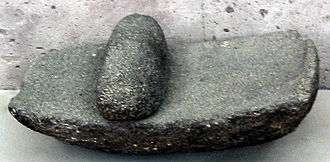 | ||
| Part of iron pitchfork, found near Lake Van and Iron plowshare, found during excavations in Rusahinili (Toprakkale). | Urartian saddle quern | |||
According to archaeological data, farming on the territory of Urartu developed from the Neolithic, even in the 3rd millennium BC. In the Urartian age, agriculture was well developed and closely related to Assyrian methods on the selection of cultures and methods of processing.[54] From cuneiform sources, it is known that in Urartu grew wheat, barley, sesame, millet, and emmer, and cultivated gardens and vineyards. Many regions of the Urartu state required artificial irrigation, which has successfully been organized by the rulers of Urartu in the heyday of the state. In several regions remain ancient irrigation canals, constructed by Urartu, mainly during the Argishti I and Menua period, some of which are still used for irrigation.
Art and architecture
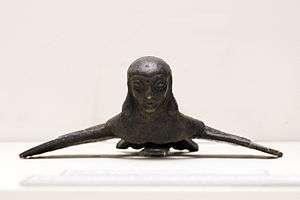
There is a number of remains of sturdy stone architecture, as well as some mud brick, especially when it has been burnt, which helps survival. Stone remains are mainly fortresses and walls, with temples and mausolea, and many rock-cut tombs. The style, which developed regional variations, shows a distinct character, partly because of the greater use of stone compared to neighbouring cultures. The typical temple was square, with stones walls as thick as the open internal area but using mud brick for the higher part. These were placed at the highest point of a citadel and from surviving depictions were high, perhaps with gabled roofs; their emphasis on verticality has been claimed as an influence of later Christian Armenian architecture.[55]
The art of Urartu is especially notable for fine lost-wax bronze objects: weapons, figurines, vessels including grand cauldrons that were used for sacrifices, fittings for furniture, and helmets. There are also remains of ivory and bone carvings, frescos, cylinder seals and of course pottery. In general their style is a somewhat less sophisticated blend of influences from neighbouring cultures. Archaeology has produced relatively few examples of the jewellery in precious metals that the Assyrians boasted of carrying off in great quantities from Musasir in 714 BC.[55]
Religion
With the expansion of Urartian territory, many of the gods worshipped by conquered peoples were incorporated into the Urartian pantheon as a means of confirming the annexation of territories and promoting political stability. Some main gods and goddesses of the Urartian pantheon include:[56]
While the Urartians incorporated many deities into their pantheon, they appeared to be selective in their choices. Although many Urartian kings made conquests in the North, such as the Lake Sevan region, many of those peoples' gods remain excluded. This was most likely the case because Urartians considered the people in the north to be barbaric, and disliked their deities as much as they did them. Good examples of incorporated deities however are the goddesses Bagvarti (Bagmashtu) and Selardi, both potentially of Armenian origins. On Mheri-Dur (Meher-Tur) (the "Gate of Mehr"), overlooking modern Van, an inscription lists a total of 79 deities, and what type of sacrificial offerings should be made to each; goats, sheep, cattle, and other animals served as the sacrificial offerings. Urartians did not practice human sacrifice.[57]
The pantheon was headed by a triad made up of Ḫaldi (the supreme god), Theispas (Teisheba, god of thunder and storms, as well as sometimes war), and Shivini (a solar god). Their king was also the chief-priest or envoy of Ḫaldi. Some temples to Ḫaldi were part of the royal palace complex, while others were independent structures.
Ḫaldi was not a native Urartian god but apparently an obscure Akkadian deity (which explains the location of the main temple of worship for Ḫaldi in Musasir, believed to be near modern Rawandiz, Iraq).[58] Ḫaldi was not initially worshipped by Urartians, at least as their chief god, as his cult does not appear to have been introduced until the reign of Ishpuini.[58]
Theispas was a version of the Hurrian god, Teshub.[59]
According to Diakonoff and Vyacheslav Ivanov, Shivini (likely pronounced Shiwini or Siwini) was likely borrowed from the Hittites.
Population
Urartologist Paul Zimansky speculated that the Urartians (or at least the ruling family) may have emigrated northwest into the Lake Van region from their religious capital Musasir (Ardini).[28] According to Zimansky, the Urartian ruling class were few in number and governed over an ethnically, culturally, and linguistically diverse population. Zimansky went so far as to suggest that the kings of Urartu might have come from various ethnic backgrounds themselves.[60]
Language
The written language that the kingdom's political elite used is retroactively referred to as Urartian, which is attested in numerous cuneiform inscriptions throughout Armenia and eastern Turkey. It is unknown what languages were spoken by the peoples of Urartu at the time of the existence of the Kingdom of Van, in addition to Urartian, but there is evidence of linguistic contact between the proto-Armenian language and the Urartian language at an early date (sometime between the 3rd—2nd millennium BC), occurring prior to the formation of the kingdom.[2][61][62][4][63]
Urartian language
"Urartian language" is the name retroactively applied by historians and linguists to the extinct language used in the cuneiform inscriptions of the Kingdom of Urartu. Other names used to refer to the language are "Khaldian" ("Ḫaldian"), or "neo-Hurrian". The latter term is considered problematic, however, as it is now thought that Urartian and Hurrian share a common ancestor rather than the previously held belief that Urartian developed directly from, or was a dialect of, Hurrian.[46] In fact, according to Paul Zimansky:[64]
The earliest dialect of Hurrian, seen in the Tiš-atal royal inscription and reconstructed from various early second millennium B.C.E. sources, shows features that disappeared in later Hurrian but are present in Urartian (Wilhelm 1988:63). In short, the more we discover or deduce about the earliest stages of Hurrian, the more it looks like Urartian (Gragg 1995:2170).
The Urartian language is an ergative-agglutinative language, which belongs to neither the Semitic nor the Indo-European language families, but to the Hurro-Urartian language family, which is not known to be related to any other language or language family, despite repeated attempts to find genetic links.
Examples of the Urartian language have survived in many inscriptions, written in the Assyrian cuneiform script, found throughout the area of the Kingdom of Urartu. Although, the bulk of the cuneiform inscriptions within Urartu were written in the Urartian language, a minority of them were also written in Akkadian (the official language of Assyria).
There are also claims of autochthonous Urartian hieroglyphs, but this remains uncertain.[65] Unlike the cuneiform inscriptions, Urartian hieroglyphic have not been successfully deciphered. As a result, scholars disagree as to what language is used, or whether they even constitute writing at all. The Urartians originally would have used these locally developed hieroglyphs, but later adapted the Assyrian cuneiform script for most purposes. After the 8th century BC, the hieroglyphic script would have been restricted to religious and accounting purposes.

The Kingdom of Urartu, during its dominance, had united disparate tribes, each of which had its own culture and traditions. Thus, when the political structure was destroyed, little remained that could be identified as one unified Urartian culture.[66] According to Zimansky:[67]
Far from being grounded on long standing cultural uniformities, [Urartu] was merely a superstructure of authority, below which there was plenty of room for the groups to manifest in the Anatolia of Xenophon to flourish. We need not hypothesize massive influxes of new peoples, ethnic replacement, or any very great mechanisms of cultural change. The Armenians, Carduchoi, Chaldaioi, and Taochoi could easily have been there all along, accommodated and concealed within the structure of command established by the Urartian kings.
Ultimately, little is known of what was truly spoken in the geopolitical region until the creation of the Armenian alphabet in the 4th century AD. Some scholars believe that the ethnonym "Armina" itself and all other names attested with reference to the rebellions against Darius in the Satrapy of Armenia (the proper names Araxa, Haldita, and Dādṛšiš, the toponyms Zūzahya, Tigra, and Uyamā, and the district name Autiyāra) are not connected with Armenian linguistic and onomastic material attested later in native Armenian sources, nor are they Iranian, but seem related to Urartian.[68] However, others suggest that some of these names have Armenian or Iranian etymologies.[38][69][70]
Proto-Armenian language
The presence of a population who spoke Proto-Armenian in Urartu prior to its demise is subject to speculation, but the existence of Urartian words in the Armenian language and Armenian loanwords into Urartian[71] suggests early contact between the two languages and long periods of bilingualism.[72][20] The presence of toponyms and tribal names of probable Proto-Armenian etymologies which are attested in records left by Urartian kings, such as Uelikuni, Uduri-Etiuni, and the personal name Diasuni, further supports the presence of an Armenian speaking population in at least the northern regions of Urartu.[73][74][75] It is generally assumed that Proto-Armenian speakers entered Anatolia around 1200 BC,[72][20][76]during the Bronze Age Collapse, which was three to four centuries before the emergence of the Kingdom of Van. However, recent genetic research suggests that the Armenian ethnogenesis was completed by 1200 BCE, making the arrival of an Armenian-speaking population as late as the Bronze Age Collapse unlikely.[77] Regardless, the Urartian confederation united the disparate peoples of the highlands, which began a process of intermingling of the peoples and cultures (probably including Armenian tribes) and languages (probably including Proto-Armenian) within the highlands. This intermixing would ultimately culminate in the emergence of the Armenian language as the dominant language within the region.[4]
A theory, supported by the official historiography of Armenia and experts in Assyrian and Urartian studies such as Igor M. Diakonoff, Giorgi Melikishvili, Mikhail Nikolsky, and Ivan Mestchaninov, suggests that Urartian was solely the formal written language of the state, while its inhabitants, including the royal family, spoke Proto-Armenian. This theory primarily hinges on the fact that the Urartian language used in the cuneiform inscriptions were very repetitive and scant in vocabulary (having as little as 350–400 roots). Furthermore, over 250 years of usage, it shows no development, which is taken to indicate that the language had ceased to be spoken before the time of the inscriptions or was used only for official purposes.
A complementary theory, suggested by Tamaz V. Gamkrelidze and Ivanov in 1984, places the Proto-Indo-European homeland (the location where Indo-European would have emerged from) in the Armenian Highlands, which would entail the presence of proto-Armenians in the area during the entire lifetime of the Urartian state.[78] Although this theory has less support than the more popular Kurgan hypothesis, the Armenian hypothesis would support the theory that the Urartian language was not spoken, but simply written, and postulates that the Armenian language as an in situ development of a 3rd millennium BC Proto-Indo-European language.[78]
See also
References
Footnotes
- Paul Zimansky, "Urartian material culture as state assemblage", Bulletin of the American Association of Oriental Research 299 (1995), 105.
- Diakonoff, Igor M (1992). "First Evidence of the Proto-Armenian Language in Eastern Anatolia". Annual of Armenian Linguistics. 13: 51–54. ISSN 0271-9800.
- Jacobson, Esther (1995). The Art of the Scythians: The Interpenetration of Cultures at the Edge of the Hellenic World. BRILL. p. 33. ISBN 9789004098565.
- Chahin, M. (2001). The kingdom of Armenia: a history (2nd revised ed.). Richmond: Curzon. p. 182. ISBN 978-0700714520.
- Frye, Richard N. (1984). The History of Ancient Iran. Munich: C.H. Beck. p. 73. ISBN 978-3406093975.
The real heirs of the Urartians, however, were neither the Scythians nor Medes but the Armenians.
- Redgate, A. E. (2000). The Armenians. Oxford: Blackwell. p. 5. ISBN 978-0631220374.
However, the most easily identifiable ancestors of the later Armenian nation are the Urartians.
- Lang, David Marshall (1980). Armenia: Cradle of Civilization (3rd ed.). London: Allen & Unwin. pp. 85–111. ISBN 978-0049560093.
- Eberhard Schrader, The Cuneiform inscriptions and the Old Testament (1885), p. 65.
- Abram Rigg Jr., Horace. "A Note on the Names Armânum and Urartu". Journal of the American Oriental Society, 57/4 (Dec., 1937), pp. 416–418.
- Zimansky, Paul E. Ancient Ararat: A Handbook of Urartian Studies. Delmar, NY: Caravan Books, 1998, p. 28. ISBN 0-88206-091-0.
- Lang, David Marshall. Armenia: Cradle of Civilization. London: Allen and Unwin, 1970, p. 114. ISBN 0-04-956007-7.
- Redgate, Anna Elizabeth. The Armenians. Cornwall: Blackwell, 1998, pp. 16–19, 23, 25, 26 (map), 30–32, 38, 43 ISBN 0-631-22037-2.
- Freedman, David Noel; Myers, Allen C. (2000-12-31). Eerdmans Dictionary of the Bible. Amsterdam University Press. ISBN 978-90-5356-503-2.
- Hewsen, Robert H. (2000), "'Van in This World; Paradise in the Next': The Historical Geography of Van/Vaspurakan", in Hovannisian, Richard G. (ed.), Armenian Van/Vaspurakan , Historic Armenian Cities and Provinces , Costa Mesa, California: Mazda Publishers , p. 13, OCLC 44774992CS1 maint: extra punctuation (link)
- A. Y. Movsisyan, "The hieroglyphic script of van kingdom (Biainili, Urartu, Ararat)", Publishing House Gitutyun of NAS RA, Yerevan 1998.
- I. M. Diakonoff, "The Pre-history of the Armenian People". Delmar, New York (1968), p. 72. http://www.attalus.org/armenian/diakph7.htm
- Piotrovsky, Boris B. The Ancient Civilization of Urartu. New York: Cowles Book Co., Inc., 1969, 51.
- Paul Zimansky. Ecology and Empire: The Structure of the Urartian State. pp. 49-50.
- Lehmann-Haupt, C. F. Armenien. Berlin: B. Behr, 1910–1931.
- Greppin, John A.C. and Igor Diakonoff Some Effects of the Hurro-Urartian People and Their Languages upon the Earliest Armenians, Oct-Dec 1991, pp. 727.
- Zimansky, Paul Ecology and Empire: The Structure of the Urartian State, 1985, pp. 67.
- Oriental Studies in the USSR. Indiana University: Nauka Publishers, Central Department of Oriental Literature. 1988. p. 312.
In his view, the first Armenian state was the kingdom of "The House of Togarmah" in the area of Melid (Melitene, modern Malatya) on ... Here, as we know from the abovementionaed inscriptions, “Armenia” and “Urartu” were synonyms ...
- Josephus. Antiquities of the Jews. Translated by Whiston, William. 1.3.5 – via PACE: Project on Ancient Cultural Engagement.
- "The Book of Genesis: Chapter 8". LatinVulgate.com. Mental Systems, Inc. Retrieved 8 June 2018.
- 2 kings 19:37
- 2 kings 19:37
- Brand, Chad; Mitchell, Eric; Staff, Holman Reference Editorial (November 2015). Holman Illustrated Bible Dictionary. B&H Publishing Group. ISBN 978-0-8054-9935-3.
- Zimansky, Paul Urartu and the Urartians, pp. 557
- Urartian Material Culture As State Assemblage: An Anomaly in the Archaeology of Empire, Paul Zimansky, Page 103 of 103-115
- D.D. Luckenbill, Ancient Records of Assyria and Babylonia, (1927, vol II:84), quoted in Robin Lane Fox, Travelling Heroes in the Epic Age of Homer (2008:17).
- Georges Roux - Ancient Iraq page 314
- Journal of Ancient History 1951, No 3. Pages. 243–244
- Letter of Ashubanipal to Sarduri III. HABL, № 1242.
- Chahin, M. (2001). The Kingdom of Armenia: A History. Psychology Press. p. 107. ISBN 978-0-7007-1452-0.
- Kurdoghlian, Mihran (1994). Badmoutioun Hayots, Volume I (in Armenian). Hradaragoutioun Azkayin Oussoumnagan Khorhourti. pp. 46–48.
- "Urartu – Lost Kingdom of Van". Archived from the original on 2015-07-02. Retrieved 2015-06-18.
- Van de Mieroop, Marc. A History of the Ancient Near East c. 3000 – 323 BC. Cornwall: Blackwell, 2006, p. 205. ISBN 1-4051-4911-6.
- Daryaee, Touraj The Fall of Urartu and the Rise of Armenia, 2018, pp. 39.
- Hewsen, R. H. "AYRARAT". Encyclopædia Iranica. Retrieved 2012-09-03.
- Armen Asher The Peoples of Ararat. 2009, p. 291. ISBN 978-1-4392-2567-7.
- The Cambridge ancient history. Edwards, I. E. S. (Iorwerth Eiddon Stephen), 1909-1996., Gadd, C. J. (Cyril John), 1893-1969., Hammond, N. G. L. (Nicholas Geoffrey Lemprière), 1907-2001., Boardman, John, 1927-, Lewis, David M. (David Malcolm), Walbank, F. W. (Frank William), 1909-2008. (3rd ed.). Cambridge [England]: Cambridge University Press. 1970-<2005>. pp. 314. ISBN 978-0521850735. OCLC 121060.
In 1828, a French scholar, J. St Martin, [...] began to grope towards an explanation by connecting [Urartian cuneiform inscriptions] with the garbled legends preserved by an Armenian chronicler, Moses of Khorene (Moses Khorenatsi), probably of the eighth century A.D., according to whom the region was invaded from Assyria by a great army under its queen Semiramis who built a wondrous fortified city, citadel, and palaces at Van itself beside the lake. [...] It is clear that by the time of Moses of Khorene all other memory of this kingdom [Kingdom of Urartu], once the deadly rival of Assyria itself, had been forgotten and remained so, except for these popular legends.
Check date values in:|date=(help)CS1 maint: others (link) - The heritage of Armenian literature. Hacikyan, A. J. (Agop Jack), 1931-, Basmajian, Gabriel., Franchuk, Edward S., Ouzounian, Nourhan. Detroit: Wayne State University Press. ©2000-2005. pp. 31. ISBN 978-0814328156. OCLC 42477084.
The story [of the legend of Hayk] retains a few remote memories from tribal times, and reflects the struggles between Urartu-Ararat and Assyro-Babylonia from the ninth to the seventh centuries B.C. The tale had evolved through the ages, and by the time Movses Khorenatsi heard it and put it into writing, it had already acquired a coherent structure and literary style.
Check date values in:|date=(help)CS1 maint: others (link) - Anatolian Iron Ages 5 : proceedings of the Fifth Anatolian Iron Ages Colloquium held at Van, 6-10 August 2001. Çilingiroğlu, Altan., Darbyshire, G. (Gareth), British Institute of Archaeology at Ankara. London: British Institute at Ankara. 2005. p. 146. ISBN 978-1912090570. OCLC 607821861.
What had for some time attracted the attention of scholars, and had led the Iranianist Saint-Martin of the Académie des Inscription in Paris to send the young Schulz to explore these sites [in Van], was to be found written in chapter 16 of Khorenatsi's work.
CS1 maint: others (link) - Lang, pp. 112, 117
- Diakonov, I. The Pre-history of the Armenian People. Delmar, NY: Caravan Books, 1984.
- Zimansky, Paul "Urartian and Urartians." The Oxford Handbook of Ancient Anatolia (2011): 556.
- "Eight Millennia of Matrilineal Genetic Continuity in the South Caucasus". Current Biology. June 29, 2017. Archived from the original on 2020-02-04.
To shed light on the maternal genetic history of the region, we analyzed the complete mitochondrial genomes of 52 ancient skeletons from present-day Armenia and Artsakh spanning 7,800 years and combined this dataset with 206 mitochondrial genomes of modern Armenians. We also included previously published data of seven neighboring populations (n = 482). Coalescence-based analyses suggest that the population size in this region rapidly increased after the Last Glacial Maximum ca. 18 kya. We find that the lowest genetic distance in this dataset is between modern Armenians and the ancient individuals, as also reflected in both network analyses and discriminant analysis of principal components.
[...]
A total of 19 archaeological sites are represented, covering large parts of Armenia as well as Artsakh (Figure 1), and estimated to be between 300–7800 years old based on contextual dating of artifacts. This time span is accompanied by at least seven well-defined cultural transitions: Neolithic, Chalcolithic, Kura-Araxes, Trialeti-Vanadzor 2, Lchashen-Metsamor, Urartian and Armenian Classical/Medieval (Figure 1). - Zimansky, Paul E. (2011-01-01). "Urartu". The Oxford Encyclopedia of Archaeology in the Near East. Oxford University Press. doi:10.1093/acref/9780195065121.001.0001. ISBN 978-0-19-506512-1. Retrieved 2018-11-22.
- Burney, Charles (2009-01-01). "Urartu". The Oxford Companion to Architecture. Oxford University Press. doi:10.1093/acref/9780198605683.001.0001. ISBN 978-0-19-860568-3. Retrieved 2018-11-22.
- Dan, Roberto (2014). "Inside the Empire: Some Remarks on the Urartian and Achaemenid Presence in the Autonomous Republic of Nakhchivan". Iran & the Caucasus. 18 (4): 327–344. doi:10.1163/1573384X-20140402. ISSN 1609-8498. JSTOR 43899165.
- Lynch, H.F.B. Armenia, Travels and Studies, Volume 2. London: Longmans, 1901, p. 54.
- "Underwater ruins of 3,000-year-old castle discovered in Turkey". Daily Sabah. Turkey. 12 November 2017. Retrieved 21 November 2017.
- Redgate, Anne Elizabeth (2000). The Armenians. Wiley. ISBN 978-0-631-22037-4.CS1 maint: ref=harv (link), p. 276.
- Piotrovskii, Boris, B. Ванское царство (Урарту), Moscow: Vostochnoy Literaturi Publishing, 1959.
- C. A. Burney, "Urartian". Grove Art Online, Oxford Art Online. Oxford University Press, accessed December 30, 2012, online, subscription required
- Piotrovsky, Boris B. (1969). The Ancient Civilization of Urartu: An Archaeological Adventure. Cowles Book Co. ISBN 978-0-214-66793-0.
- Chahin, Mark (1987). The Kingdom of Armenia. Dorset Press. ISBN 978-0-88029-609-0.
- Zimansky, Paul (2012). Imagining Haldi. p. 714.
- (Encyclopædia Britannica)
- Urartian Material Culture As State Assemblage: An Anomaly in the Archaeology of Empire, Paul Zimansky, Page 103 of 103–115
- Róna-Tas, András.Hungarians and Europe in the Early Middle Ages: An Introduction to Early Hungarian History. Budapest: Central European University Press, 1999 p. 76 ISBN 963-9116-48-3.
- Greppin, John A. C. (1991). "Some Effects of the Hurro-Urartian People and Their Languages upon the Earliest Armenians". Journal of the American Oriental Society. 3 (4): 720–730. doi:10.2307/603403. JSTOR 603403.
Even for now, however, it seems difficult to deny that the Armenians had contact, at an early date, with a Hurro-Urartian people.
- Scarre, edited by Chris (2013). Human past : world prehistory and the development of human societies (3rd ed.). W W Norton. ISBN 978-0500290637.CS1 maint: extra text: authors list (link)
- Sayce, Archibald H. "The Kingdom of Van (Urartu)" in Cambridge Ancient History. Cambridge: Cambridge University Press, 1982, vol. 3, p. 172. See also C. F. Lehman-Haupt, Armenien Einst und Jetzt, Berlin, 1931, vol. 2, p. 497.
- Armen Asher The Peoples of Ararat. 2009, p. 290-291. ISBN 978-1-4392-2567-7.
- Zimansky, Paul "Xenophon and the Urartian legacy." Dans les pas des Dix-Mille (1995): 264-265
- Schmitt, R. "ARMENIA and IRAN i. Armina, Achaemenid province". Encyclopædia Iranica. Retrieved 2012-09-03.
- DADARSIS, 2011
- Dandamaev, M.A. "Title of article", A Political History of the Achaemenid Empire, 1989
- Petrosyan, Armen. The Armenian Elements in the Language and Onomastics of Urartu. Aramazd: Armenian Journal of Near Eastern Studies. 2010. (https://www.academia.edu/2939663/The_Armenian_Elements_in_the_Language_and_Onomastics_of_Urartu)
- Encyclopedia of Indo-European culture. Mallory, J. P., Adams, Douglas Q. London: Fitzroy Dearborn. 1997. pp. 30. ISBN 978-1884964985. OCLC 37931209.
Armenian presence in their historical seats should then be sought at some time before c 600 BC; ... Armenian phonology, for instance, appears to have been greatly affected by Urartian, which may suggest a long period of bilingualism.
CS1 maint: others (link) - Armen Petrosyan. https://www.academia.edu/33109045/Indo-European_wel-_in_Armenian_mythology._Journal_of_Indo-European_studies_2016_1-2_pp._129-146
- Armen Petrosyan (September 1, 2010). The Armenian Elements In The Language And Onomastics Of Urartu. Association For Near Eastern And Caucasian Studies. p. 137. Retrieved 16 February 2020.
- Hrach Martirosyan (2014). "Origins and Historical Development of the Armenian Language". Leiden University: 9. Retrieved 16 February 2020.
- Sargis Petrosyan (2019). Light Worship in Etiuni Lands. http://shirak.asj-oa.am/663/1/5%2D19.pdf
- Haber, Marc; Mezzavilla, Massimo; Xue, Yali; Comas, David; Gasparini, Paolo; Zalloua, Pierre; Tyler-Smith, Chris (2015). "Genetic evidence for an origin of the Armenians from Bronze Age mixing of multiple populations". European Journal of Human Genetics. 24 (6): 931–6. bioRxiv 10.1101/015396. doi:10.1038/ejhg.2015.206. PMC 4820045. PMID 26486470.
- Gamkrelidze, Tamaz V.; Ivanov, Vyacheslav (1995). Indo-European and the Indo-Europeans: A Reconstruction and Historical Analysis of a Proto-Language and Proto-Culture. Part I: The Text. Part II: Bibliography, Indexes. Walter de Gruyter. ISBN 978-3-11-081503-0.CS1 maint: ref=harv (link)
Literature
- Ashkharbek Kalantar, Materials on Armenian and Urartian History (with a contribution by Mirjo Salvini), Civilisations du Proche-Orient: Series 4 – Hors Série, Neuchâtel, Paris, 2004;ISBN 978-2-940032-14-3
- Boris B. Piotrovsky, The Ancient Civilization of Urartu (translated from Russian by James Hogarth), New York:Cowles Book Company, 1969.
- M. Salvini, Geschichte und Kultur der Urartäer, Darmstadt 1995.
- R. B. Wartke, Urartu — Das Reich am Ararat In: Kulturgeschichte der Antiken Welt, Bd. 59, Mainz 1993.
- P. E. Zimansky, Ecology and Empire: The Structure of the Urartian State, [Studies in Ancient Oriental Civilization], Chicago: Oriental Institute, 1985.
- P. E. Zimansky, Ancient Ararat. A Handbook of Urartian Studies, New York 1998.
External links
| Wikimedia Commons has media related to Urartu. |
- Livius History of Urartu/Armenia
- Historical Maps of Urartu at WikiMedia Commons
- An Urartian Ozymandias – article by Paul Zimansky, Biblical Archaeologist
- Urartu Civilization
- Urartu (Greek Ararat)
- Capital and Periphery in the Kingdom of Urartu, Yehuda Dagan, Israel Antiquities Authority

